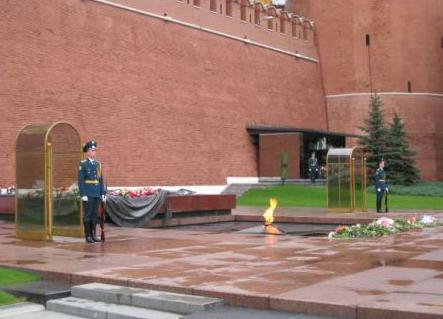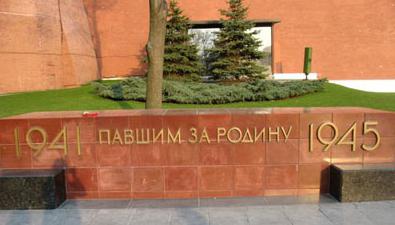The Second World War for our country is still the most tragic and great event in our history. The memory of those killed in these years is immortalized in many monuments and monuments that are located in all cities of Russia. A lot of unidentified soldiers were buried during the war. To honor their feat, a monument to the Unknown Soldier is erected on such graves. There is such a memorial in Moscow - in the Alexander Garden near the Kremlin wall.
The value of such monuments
All over the world, monuments to those killed in the war are being erected so that people remember what the soldiers gave their lives for. The graves of soldiers are often nameless, and before they did not come to honor their memory. But after one of the most bloody wars - the First World War - a tradition was formed to perpetuate the memory of such soldiers in monuments. They are usually installed at the burial site. So the descendants express their gratitude and respect to the soldiers who died in battle. The first monument to the Unknown Soldier was erected in Paris in November 1920. Something similar was created in Russia at the same time, however, this memorial symbolized the memory of the heroes who died for the revolution.
The history of the monument to the unknown soldier
In the Soviet Union, large-scale celebrations of victory in the Great Patriotic War began only in 1965. At this time, our capital, like many other cities, was given the status of a hero city, and on May 9 it became a national holiday. On the eve of the anniversary of the great battle for Moscow, the government of the country thought about how to create a monument that could perpetuate the feat of the city’s defenders. It was supposed to be a memorial of national significance. Therefore, we stopped at installing a monument to the unknown soldier.

Moscow was an ideal place for this, because thousands of soldiers died in battles for the city, and a lot of them were not identified. A competition was announced to create the monument. The best project was recognized by the architect V.A. Klimov. He believed that such a monument should be located in the park, so that a person could sit next to him and think. The best place for him was chosen near the Kremlin wall - a symbol of Russia's invincibility. And in 1966, work began on the monument. It was created by architects V.A. Klimov, D.I. Burdin and Yu.R. Rabaev. The most famous writers and poets were attracted to create inscriptions on the monument. The words of S. Mikhalkov were recognized as the best: "Your name is unknown, your feat is immortal." The grand opening of the monument took place on the eve of Victory Day in 1967. In subsequent years, it was repeatedly supplemented with new elements and restored. To this day, the Monument to the Unknown Soldier remains a symbol of victory in the Great Patriotic War.
How was the burial of the ashes of a warrior
Before creating the memorial, they thought for a long time who to bury in the grave under the monument. After all, it must be an unidentified warrior who died in the battles for Moscow. And in 1966, forty kilometers from the city, in Zelenograd, a mass grave was discovered. A soldier who wore a well-preserved uniform was chosen in it. Specialists guaranteed that he was not a deserter, otherwise he would not have a belt. This warrior could not be a prisoner, as in this place there was no fascist occupation. On December 2, the soldier was transferred to a coffin, entwined with a St. George ribbon. A wartime soldier's helmet was put on the lid. Until the morning, young soldiers and war veterans stood next to him in the guard of honor. On the morning of December 3, along the Leningradskoye Shosse, as part of a funeral procession, the coffin was taken to Moscow. In front of the Alexander Garden, the coffin was transferred to an artillery carriage. The whole procession was accompanied by a guard of honor, nearby, to the sounds of the mourning march, war veterans walked and carried unfolded combat banners.
How the monument was created
After the burial of the ashes of the unknown soldier - a month later - they began to create the memorial itself. He did not look at that time as it is now, then the composition was supplemented several times. At first, the memorial was a granite slab with the words of S. Mikhalkov, a tombstone over the grave and a bronze star with the Eternal Flame. A granite wall was made next to the monument, on which the names of all the hero cities are immortalized. The opening of the monument took place in a festive atmosphere: the national anthem was performed and the fireworks thundered. The Eternal Flame, which was brought from the Field of Mars in Leningrad, was also lit. The memorial was supplemented in 1975 with a bronze composition - a soldier's helmet on a detailed banner.
What is a monument now
Modern youth may not even answer what kind of monument it is and what its significance is. But for most people this war still remains the Great Patriotic War, and until now the monument to the unknown soldier is the place of laying wreaths on holidays, it is visited by foreign delegations. Near him there are always people who came to honor the memory of the dead. Since 1997, Post No. 1 has been located next to the monument. Warriors of the Presidential Regiment replace each other every hour. In 2009, the reconstruction of the complex began. At this time, the Eternal Flame was transferred to Poklonnaya Gora, and after the opening of the updated monument in 2010, it was returned back. During the restoration, a ten-meter stele was added to the memorial, perpetuating the memory of cities of military glory.
Description of the monument to the unknown soldier
The memorial is located in the Alexander Garden under the Kremlin wall. Every person who comes to Moscow considers it his duty to visit the monument to an unknown soldier. A photo of him can be found in all books devoted to the Great Patriotic War, in newspapers and on the Internet. But it’s still better to see it in reality. The composition is made of brilliant red granite and black labradorite. On the tombstone is a bronze soldier's helmet, lying on a detailed banner. In the center of the square of mirror-polished black stone is a bronze star. Eternal flame bursts from it. On the right lies a low stela 10 meters long, on which the names of cities of military glory are embossed. And the memory of heroic cities is immortalized on a granite alley of raspberry quartzite.

This memorial is known all over the world and is now one of the sights of Moscow. People come here not only on Victory Day, but simply honor the memory of the fallen and pay tribute to the feat of the defenders of the Motherland.